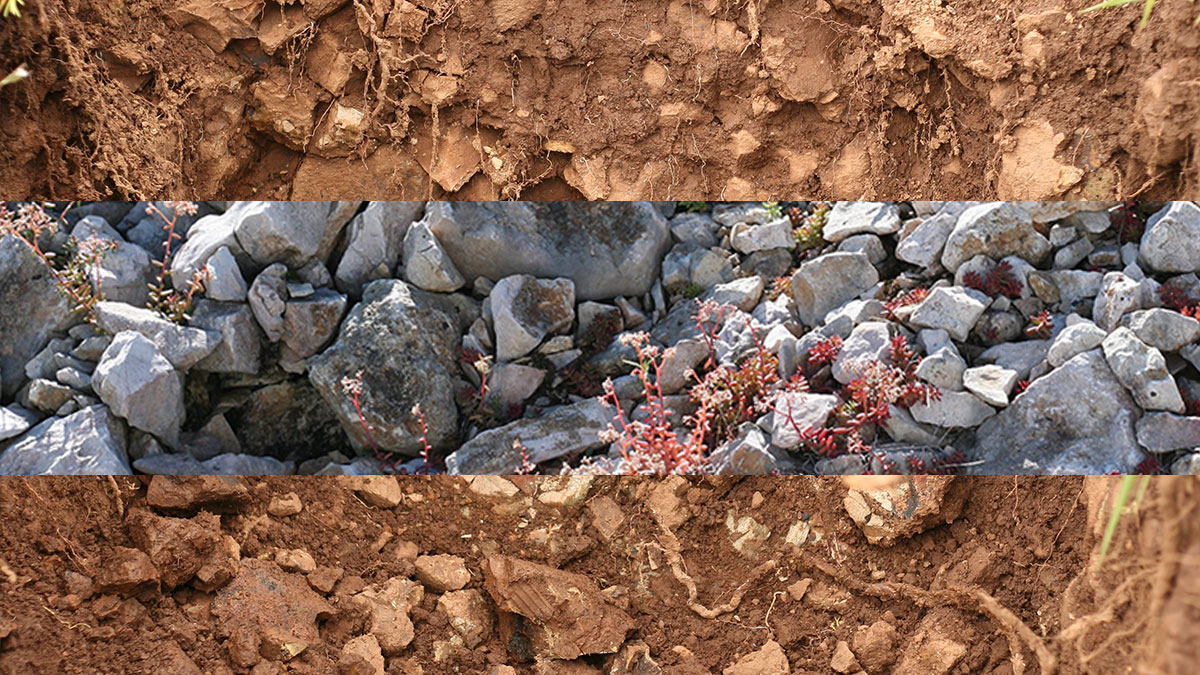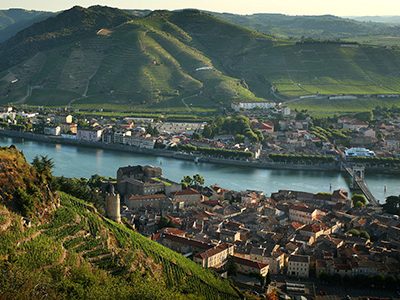Name a great wine region on basalt. It’s volcanic rock that surfaced as lava, spread out in tongues and cooled into vineyard soils in Mount Etna, the Canary Islands and throughout the Pacific northwest. No mention of Burgundy.
“In France, basalt is the Massif Central,” says Mark Tarlov, joking about what might seem to be a quixotic goal: to understand the terroir of Oregon, a place with soil that doesn’t exist in the great vineyards of France, where the term was invented.
The Willamette Valley has drawn Tarlov, a film producer from New York, and, more recently, a wine producer in these western reaches of the Columbia Basin. It has drawn in Larry Stone, a Master Sommelier from Chicago and San Francisco, and, more recently, a wine producer here as well. Both men are obsessively fascinated by the concept of terroir and have enlisted winemaking partners from Burgundy—Louis Michel Liger-Belair, in the case of Tarlov’s Chapter 24; Dominique Lafon, in the case of Stone’s Lingua Franca.
In fact, if you dig a hole in the Willamette basalt, you’re likely to find a Burgundy winemaker standing in it soon. It might be Jacques Lardière, who directed winegrowing at Maison Louis Jadot before starting Résonance, his retirement project for the firm; or Jean-Nicolas Méo, who teamed with former music executive Jay Boberg, at Nicolas-Jay. The list continues to grow.
Our vocabulary, however, does not. Wine producers, buyers and sellers, writers as well as wine drinkers all continue to describe Willamette Valley pinot noir as Burgundian, even as the soil differences are black and white. There must be a more useful word, particularly for the small but growing number of delicate, detailed red wines the pinot-noir vineyards of Willamette now produce.
Terroir, as defined by the monks who parsed the vineyards of Burgundy, is not just the soil, but also the climate, the direction of the hill, as well as the traditions of the people who work the land and the vines. It was the climate that drew the first Burgundy producer to the Willamette: Robert Drouhin’s interest in the region dates back to its earliest days as a pinot-noir vineland.
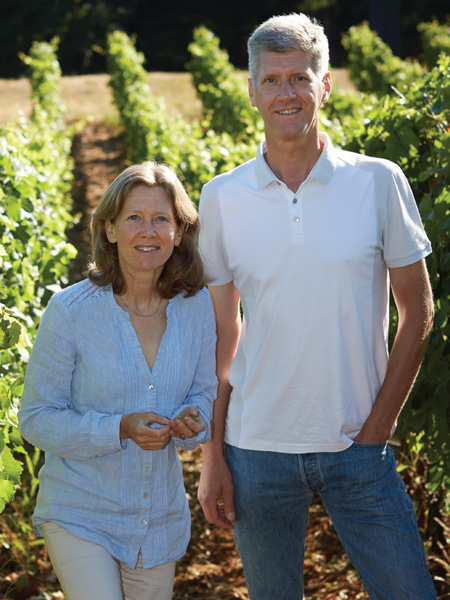

Philippe Drouhin—Robert’s son and the viticulturist for Maison Joseph Drouhin in the Côte d’Or, Domaine Drouhin Oregon in Dundee and Roserock in the Eola–Amity Hills—recalls how the family got its start in the Willamette. “My father traveled here in the 1960s,” Philippe says. “He saw some vineyards and tasted some wines, from David Lett in particular.” Lett, a black sheep from UC Davis, had abandoned California for the Willamette hills, bringing pinot noir cuttings and searching out a site that might be more accommodating to the vine than the sunny Golden State. “There was something my father liked in the wines,” Philippe says. “He could find qualities in the wines that resembled the qualities he was looking for in Burgundy.”
Then, in 1979, there was the “Wine Olympics,” a tasting in Paris organized by the French magazine Gault Millau. David Lett’s Eyrie Pinot Noir from 1975 did particularly well in the international competition, and Robert Drouhin asked Gault Millau to recreate the pinot-noir tasting, regrouping with the Drouhin wines at his cellars in Beaune. “The wine from David Lett came very close to the very best Burgundy from Drouhin,” Philippe explains. “Years passed, and Véronique [Philippe’s sister] did her oenology degree; she spent some time in Oregon, and my father visited her. Around a glass of wine, he said to a few people there, ‘If one day I decided to invest outside of Burgundy, I certainly would invest in Oregon.’ Then, at Vinexpo, David Lett told him, ‘There is a piece of land for sale.’ It was touching Lett’s property. He asked, ‘Are you interested?’ My father flew to Oregon and he purchased the land.”
It was a commitment based on taste and observation. “It was not the result of a very scientific study of the terroirs around the world,” Philippe admits. “But he liked the wines and it was a cool climate, so he decided to make the investment.”
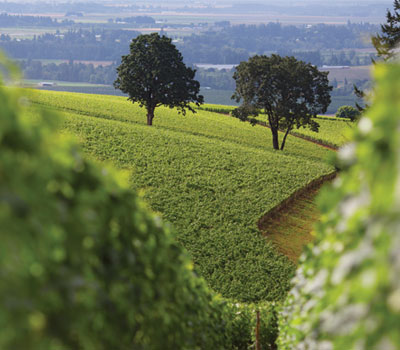

“We are not able to tell, just by looking at soil, if this land will make grand cru wine. The French did not produce their grand cru maps based on soil studies. The wine was their tool of measurement of the quality of the terroir.” —Philippe Drouhin
Last year, I met Philippe Drouhin outside a small stone hut in the Clos des Mouches, one of the family’s Beaune vineyards. It’s difficult to imagine the hut was built for anyone even close to his six and a half feet. Standing at the edge of the vines, we talked about how he converted the estate to biodynamic farming in the 1990s, and what he has learned about this hillside of stark white limestone.
“The pattern of water availability is the key thing,” he said. “This has very little soil; in less than a meter, there are layers of fractured rock. The roots are able to go under and in between. They look like Egyptian paintings,” he said, holding his hands out in parallel, like a hieroglyph.
The soil Drouhin found when he arrived in Dundee, two years after his father purchased the land, was deep and black. In some areas, the soil was sixteen inches, but in many parts of the vineyard, the soil was more than six feet deep.
The family started to plant the vineyard in 1988, based on what was typical in Oregon at the time: two heritage selections of Pommard and Wadenswil, the vines widely spaced, planted on their own roots. The next year, they grafted some Pommard on rootstock. And then, in the early 1990s, Oregon State University released its first Dijon clones from quarantine. “We started to plant them as soon as they were available,” Drouhin said.
In Oregon, Drouhin was struck by the way the plants behaved. “The first thing that surprised me was how fast everything grows, including vineyards,” he recalled. However, he could perceive few visual differences in the vines throughout the vineyard; in Burgundy, he was used to seeing visual cues, differences the vines might show between one place and another 30 feet away. “In Oregon, the vines looked more homogeneous; they had big growing potential,” he explained.
To battle the vigorous growth, he began to plant more vines per acre and to experiment with different rootstocks. He also hired Yves Hérody, a geologist based in Jura, whose firm, Bureau de Recherches sur le Développement Agricole, or BRDA, did a lot of work in the Côte d’Or. “He mapped our estate to tell me what differences he found and what that would mean to him agronomically. That gave me extra information to add to what I could see. Since we are planting a little bit at random, not knowing the terroir, if, at some point, we discover that a particular area makes a good wine—not knowing why—I could look at this map and see if there is another part of the estate that might make a similar wine. It’s a slow process to tell which areas on the estate are best and which rootstocks are best suited, but you have to start somewhere.”
Most vignerons in Burgundy work small plots, often making farming decisions with some empirical knowledge passed down from a parent who farmed the same vines. “In Burgundy, I know the vineyards so well I know exactly where to go, if I’m looking for a particular disease, or where to look for vigor,” Drouhin said. The sheer expanse of Drouhin’s Oregon vineyards, each of which covers more than 100 acres, requires a different approach. Along with Hérody’s soil maps, Drouhin also uses maps that track the NDVI (Normalized Difference Vegetative Index), which measures the vigor of the vines by comparing satellite data on the wavelengths of light emanating from the plants. He uses both sets of maps to help focus his time on the ground.
“It’s not an exact science at all, and the French did not produce their grand cru maps based on soil studies. The wine was their tool of measurement of the quality of the terroir.” Drouhin pointed out that, even today, the INAO (Institut National de l’Origine et de la Qualité) makes their decisions about the appellation controlée system based on the wines themselves. “If a group petitions for a change [in the classification], the INAO will drink the wines from those producers for ten years to see. We are not able to tell, just by looking at soil, if this will make grand cru wine.”
Mapping the soils has helped Drouhin successfully grow markedly different wines at his two Oregon vineyards. In fact, the family had decided to purchase Roserock in 2013 based on wine they had made from the site for several years. Tasting the wines side by side in our New York office, the difference was striking. The pinot noirs grown in the deep soils at Drouhin’s Dundee Hills estate are rich, savory reds without excess weight, their textures silken, their tannins gentle. The Roserock wines, on the other hand, have a more rustic firmness to the structure, something a vigneron from Burgundy might describe as minerality.
“At Roserock, there is rock everywhere. I like that very much; I’m used to having rock in Burgundy. It’s good for reducing compaction; it’s good for roots touching the rock—when there is less water in the soil, those rocks can give back some water, and it will have a different concentration of minerals. So, rocky soil is interesting from many points of view.”
It’s certainly interesting for the character of the wine it grows. Drouhin pointed to a wide range of factors—including the shallow soils with rock on the surface, less available water in the soil and the cooling influence of winds through the Van Duzer corridor that slows ripening. The 2014 Zépherine, a barrel selection from Roserock, is as quiet as the Laurène, from the Dundee Hills property, though more detailed in its savory tannins. Zépherine is a wine with delicate intensity; its structure gives the impression of tension.
The rocky soils of the Eola–Amity Hills have attracted others to the region. Though more remote from the prosperity of Portland than Dundee, this collection of hills has sustained several generations of farmers. From the first vinifera plantings in 1971 at Amity Vineyards through to its approval as an appellation in 2006, the Eola–Amity Hills have gained attention for a distinctive character in their red wines, what one grower described to me as a youthful, reductive stink—or, translated to give the positive impression he intended, tension.
It was a site in the Eola–Amity Hills that first tempted Dominique Lafon to work in Oregon. Mark Tarlov had just purchased the Seven Springs Vineyard for his new project, Evening Land Vineyards, and invited the Meursault-based vigneron at Domaine des Comte Lafon to join his team.
Earlier, Tarlov had asked him to consult at Evening Land Vineyards in California, but Lafon declined. “To me, the success in California pinot noir was more about richness and power,” Lafon explained from his office in Meursault. “It was not my style of wine, and if I was going toward more elegance, it would not be well received. So, I said, No, I don’t think I should go for that.”
A year later, Tarlov called to say he was looking at a vineyard in Oregon. Lafon was friends with the Drouhins and, over the years, had developed friendships with other local growers. “So, I took a flight to Portland and I visited Seven Springs. When I walked the vineyard, I said yes. I could express myself with the type of climate; you could go toward elegant wine in Oregon without it being seen as something crazy or stupid. That vineyard was amazing for the situation, the place, the amount of old vines, and its history—it always made great wine, but the grapes had been sold to other people.”
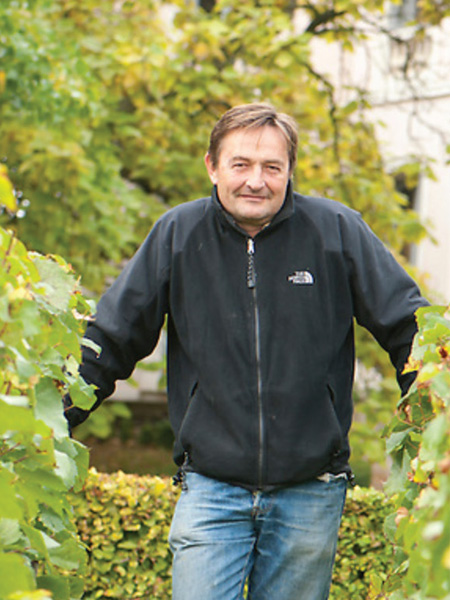

“In Oregon, we have only sunshine until after harvest; it doesn’t rain, which is not the case in Burgundy. Maybe in Burgundy we
—Dominique Lafon
look for a nice fruit because we don’t get it all the time. In Oregon, you want to make it lighter.”
Lafon started working as a consultant for Evening Land in 2007. He made a number of suggestions, including the application of biodynamic viticulture, which the team took up the following year. But he also recalls cultural pressures that made other suggestions moot. Like when to pick pinot noir.
“At the time, I was thinking exactly how everyone was thinking, that Oregon was a place for pinot noir. At Seven Springs, we had a vineyard manager and a viticulture advisor from the US. And in 2007, I had a lot of pressure to pick the pinot very late. When I said it was ripe, they said, No, you have to wait. There was big pressure to wait. But there was no pressure on chardonnay.” The variety was relatively insignificant in the region at the time. “So, I said, Go pick the chardonnay. It was no more than 22 Brix. Everyone said, You are crazy.” In fact, Evening Land’s wine from that early harvest is widely regarded as the catalyst for the contemporary flowering of Willamette Valley chardonnay. “At the time, there were a lot of people influenced by California, and their goal was to make the best of Oregon pinot noir like California,” Lafon recalls. “I said to Mark that our best wine will be the most elegant, not the bigger one.”
Lafon set out to discover the character of pinot noir at Seven Springs, “rather than to say, ‘We’re going to make a little Volnay out of Seven Springs.’” It might be the same grape, but the vines are growing on completely different soils, and, even if both regions are relatively cool, the climate is not the same. “In Oregon, we have only sunshine until after harvest; it doesn’t rain, which is not the case in Burgundy. Maybe in Burgundy we look for a nice fruit because we don’t get it all the time. In Oregon, you want to make it lighter.”
At Seven Springs, Lafon started vinifying each block separately, to determine whether the wine could be presented on its own, or what role it might play in a blend. “When you meet someone new, it takes time,” he says. La Source, Evening Land’s top selection, developed out of that process. “What we called La Source was always from the same blocks. It would go a little higher [up the hill] in warmer vintages and lower [downhill] in cooler vintages; we would taste blind, and [wine from] that middle part of the hill would always taste more elegant, with the best length.”
Larry Stone, the Master Sommelier who built his career at Charlie Trotter’s in Chicago, then at Rubicon in San Francisco, joined the Evening Land team after Lafon, in 2010. As president and general manager, he began negotiating a deal to purchase the adjacent property from the Janzen family. They were still in discussions when Stone and Tarlov left Evening Land in early 2012, each going his own way. Stone had taken a job in Napa Valley when the Jenzens approached him, later that same year. Though they’d been reluctant to sell what had been a wedding present, their circumstances had changed. Stone had a small nest egg from the sale of his Sirita project in California and, determined to buy the land, he auctioned off his personal wine cellar and convinced some family members to invest.
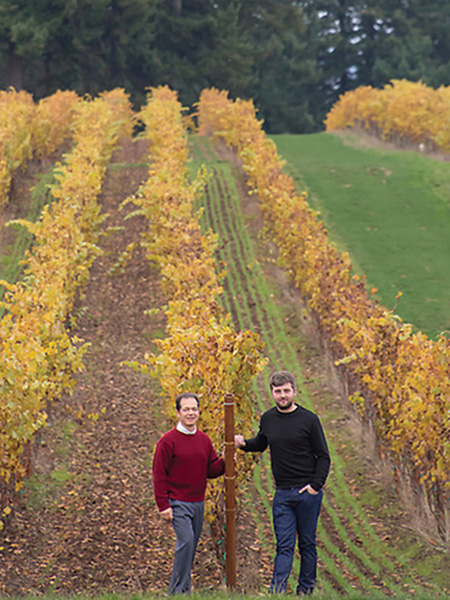

It wasn’t until after Stone and his team cleared the plum, cherry and Christmas trees and planted the hillside that Lafon left Evening Land and came to work at Lingua Franca, Stone’s new project, in February 2015. Thomas Savre, the Dijon-trained assistant winemaker at Evening Land, joined a few weeks later. Two years on, Stone still looked a little shell-shocked when I met him outside his new winery, at the base of the hillside he had recently planted to vines. The LSV Vineyard rises up toward Seven Springs, with a view to La Source. To farm the vines, Stone brought on Mimi Casteel, who grew up in the vineyards at Bethel Heights and now tends her own vines nearby. Casteel is the viticulturist for Lingua Franca, bringing her personal take on biodynamic farming to the site.
Stone led me inside to meet Savre, who helped design the winery along with Lafon, and who now makes the wines. The building felt cavernous, and Stone explained that his team was handling some custom crush projects while the LSV vines were maturing. They were also buying fruit from several growers, blending it into a range of wines from 2015. “We were trying to build as few cuvées as possible,” Stone explained, “but we ended up with two whites and five reds.”
It happened that certain wines fit together and others did not. Lafon and Savre blended the 2015 Avni from a collection of seven vineyards, six of them east-facing sites on the same slope as LSV, all within a couple miles of the winery. The 2015 Tongue’n Cheek comes from two vineyards farther north, Elton and Les Stevens, that gave a fuller, richer, darker wine that shows more bass notes and spice in its delicate strawberry flavors. “If you put Tongue’n Cheek and Avni together, they fight each other,” Stone says. There is a sensibility to the blending that goes beyond what might make technical sense. Stone describes it as “exploring Oregon with the mind of Burgundy.”
Mimi’s Mind may be Lingua Franca’s most intriguing example of Burgundy-and-Oregon brainpower. Casteel grows the fruit at her Hope Well Vineyard in Salem, bringing her work as a botanist, forester and ecologist to bear on her farming. Lafon and Savre bring an outside perspective: “In America, people want to extract,” says Stone. “The French don’t want extraction.”
Perhaps due to Casteel’s farming, and perhaps with an assist from Lafon and Savre’s gentle extraction, Mimi’s Mind is the most delicate and grounded of the Lingua Franca 2015s, with the scent of meadow flowers, and tannins that lend the wine depth and detail.
Several miles south, a different international team at Chapter 24 has been discussing how to replant the Witness Tree Vineyard, a famed property laid low by phylloxera. It’s on an east-facing slope adjacent to Cristom, with a view of Jessie’s Vineyard at the top of the hill. Chapter 24 is Tarlov’s latest venture, which also owns and farms the Black Walnut Vineyard in Dundee, purchases fruit from 15 growers and continues to search for land.
After what Tarlov describes as the coup d’etat at Evening Land, he contacted Burgundy shipper Becky Wasserman in search of a vigneron to consult with him on a new project. She put him in touch with Louis Michel Liger-Belair, the Burgundy count who studied oenology and pushed the reset on his family’s legendary domaine, which includes La Romanée, the grand cru monopole above Romanée-Conti. Liger-Belair visited Tarlov in Oregon in July 2012, and they started working together that September. They brought on Ryan Hannaford, an Australian viticulturist who had managed the biodynamic farming at Evening Land. Felipe Ramirez joined in 2015; he came into Liger-Belair’s orbit when he took time off from Bouchon in Chile’s Maule Valley to work harvest at the Vosne domaine in 2013. Fluent in French, Spanish and English, Ramirez has settled in as Chapter 24’s winemaker on the ground. Liger-Belair also brought in Pedro Parra, an international terroir consultant and one of his partners in a Chilean venture, Aristos.
Many of them were gathered this spring to dig soil pits, parsing shifts underground that would delineate their vineyard parcels. After several days spent mapping vineyards, Tarlov and the farming team joined one of their Portland investors, Ian Lombard, for dinner at the Black Walnut. Lombard, the only local in the group, had helped finance the purchase of Witness Tree and Black Walnut, an inn surrounded by vineyards in the Dundee Hills.
As Tarlov opened a range of Burgundies from the 1990s, he recalled that he was still drinking California cabernet when he met Larry Stone at Rubicon in 1994. Stone told him there were some people whose wines he should try, which is how he ended up with a cellarful of legendary Burgundies. “At the time, they were not expensive,” Tarlov said, in his matter-of-fact way.
Pedro Parra, the geologist and terroir consultant, used the wines as his own form of small talk over dinner. He described the parcel that Henri Jayer farmed for his 1995 Nuits-St-Georges as flat, colluvial terroir. “It’s young erosion, water moving the vomit off the hill. It’s the opposite of the Laurent Vaucrains,” another 1995 Nuits-St-Georges Tarlov had opened. “That’s from the middle of the slope, on the mother rock. But in Nuits, the middle of the slope is never a grand cru,” he said.
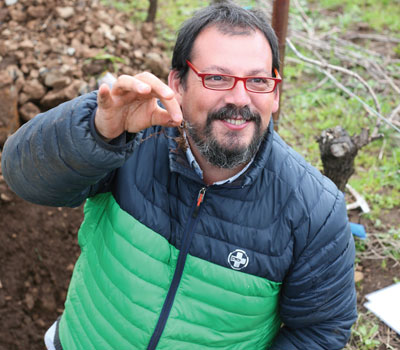

The difference, Parra asserts, is the clay. “Cras is the continuation of La Romanée,” Parra said, referencing two vineyards in Liger-Belair’s domaine, a premier-cru vineyard in Nuits-St-Georges, not far from the Vosne grand cru, and at a similar position on the hillside. “The limestone [in Cras] is fantastic. Then you taste the wine and what you get is the clay. Keh, keh, keh, keh… And you taste the Vosne Romanée and it is silky.”
In Burgundy, Parra studies the subtle shifts in the interaction of limestone and clay. In Oregon, he explained, he’s looking at the abrupt transitions from lava flows to glacial flood sediments—a morass of everything that poured up against the Willamette hills at the end of the last ice age, more than 13,000 years ago, when the ice that dammed up Lake Missoula would occasionally melt, sending its waters blasting through the Columbia Gorge. Parra holds out hope that he may yet find sedimentary rock in the Willamette, but in three years of digging soil pits, he has only found the kinds of sedimentary clays, silts and flood soils that are not the terroirs he is seeking. Instead, he’s focused on the area where the volcanic rock is close to the surface and beginning to dissolve, where the vine roots can work through fractures in the stone, breaking it up further and tethering themselves to a nest of minerals the deteriorating rock makes available, what he calls altérite.
His work has been influenced by René Morlat, a soil scientist whose PhD considered terroir, and whose work establishes Basic Terroir Units broken out as Rock, Alteration and Altérite, three stages of geological formation and decay. Parra says the concept is relevant to plant behavior in soils derived directly from mother rock (as opposed to soils built by erosion, flooding or wind).
To find these transitions in the soil, Parra searches out fractures in the rock using maps that record the electro-conductivity in the soil at two and a half feet and again at five feet. The areas with the highest electro-conductivity highlight where there is moisture—deep soils in Willamette can hold plenty of moisture. They also suggest the presence of clay. Parra is interested in clay because, unlike silt or sand, clay has negative electrical charges on its surface, which bond to positively charged cations, and studies have shown that cations are a pathway for nutrients to pass from the soil into the roots of the vine.
Parra looks for stonier soils, and digs pits where he finds lower EC ranges on the maps, to see how fractured the rocks may be, and whether roots can penetrate. He is hoping to find the right balance between altérite and clay to produce the kind of wine that Liger-Belair (“more clay-stony”) or Tarlov (“more silt-stony”) prefer. Since the cations bonded to the clay help the roots feed on the soil, he explained, he wants to find enough clay to encourage the plants to eat, but not so much that the plants get lazy and their fruit gets sweet and fat. Where there is a little clay on the surface of deteriorating rock, it supports the transfer of mineral compounds from the soil to the roots and eventually to the fruit, providing the basic structure in the wine both Tarlov and Liger-Belair want.
The clay, Parra told me, makes the difference between rustic minerality—pointing to Ribeira Sacra in Spain as an example of vines rooted directly into rock and elegant minerality, which he now believes he can find in the volcanic soils of Oregon.
I spent a day with Parra hunting for altérite, the dissolving rock. He was standing in a soil pit halfway up the hillside at Witness Tree, tapping the edges of the pit with the claw of his hammer. He pulled out a tiny nest of roots, as thin as a hair net, holding a pouch of black soil that was once a rock. “Gold!” he shouted, smiling at Ramirez and Tarlov.
While Parra was chipping away, Tarlov was standing at ground level, explaining the work of another member of the team, Jean-François Hamel, a biochemical engineer who runs a lab at MIT and focuses much of his attention on microbial life. Tarlov had tapped into Hamel’s team and their expertise in the single-cell world of yeasts to create a feedback loop, helping not only to explain some of the observations Liger-Belair and Parra were making, but also to guide some of their decisions moving forward.
He asked Hamel to study the diversity in the microbial populations on the grapes at several different vineyard sites, creating census data; the lab also analyzed flavor and aroma molecules in the grapes, and later in the wine. Tarlov said they found just under 600 compounds in the grapes, and around 1,000 after fermentation. “So, forty percent of the flavor and aroma comes from the metabolic action of the yeasts,” Tarlov asserted.
He then tied this back to the soil and to Hamel’s work on microbial populations. “Not only does the water-holding capacity of the soil affect stress on vines,” he said, “it completely changes the microbial population. And we know yeasts chemically change the flavor compounds.” As Tarlov explained, “We’re using a lot of science to jump six or eight hundred years of trial and error. We don’t have monks. We use technology.”
The wines, however, do not taste technical, but they do taste precise.
“Henri Jayer told me in 2003, ‘If I were you, I wouldn’t do any punching down.’ Even though the grapes were mature, the seeds were still green, and you would have green tannins. He said, ‘If the wine is not good from the vat, it will never be good.’”
—Louis Michel Liger-Belair
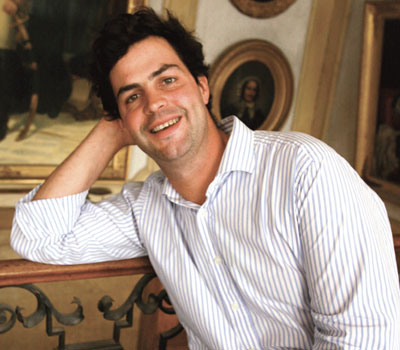

A few months later, Liger-Belair came to New York to present the 2016s. Originally, the cuvées at Chapter 24 riffed on flood soils and volcanic soils, with The Last Chapter a top blend of the two. In 2016, the team harvested based on the patterns of lava flow and the alteration of the soil, as detailed by Parra. Then Ramirez and Tarlov spent several days tending to the fermentations, feeding oxygen to the yeasts through carefully timed pump-overs. It was another bit of advice from Hamel, explicating the winemaking strategies Liger-Belair had brought to the team. Liger-Belair told me that when he asked Henri Jayer for advice on how to handle the heat of the 2003 harvest, Jayer suggested he be extremely gentle with extraction. The fact that the ripe grapes gave him lower finished alcohols than he expected caught his interest, and he fine-tuned his strategy over time. Tarlov had raised the matter with Hamel and his team at MIT, to study the science behind the seeming contradiction (that riper grapes might produce lowerthan-expected alcohol levels) and learned that it was due to the way different populations of yeasts consume oxygen, and what byproducts they produce. He also learned that if they could prolong the fermentations, feeding oxygen to the successive populations of yeasts that develop in the must, the aroma and flavor compounds in the wines would further proliferate while the alcohol levels remained relatively low. It’s the microbial life in the soil, impacting the growth of the vine and the microbial life on the fruit brought into the winery, where it interacts with yeasts already resident, all creating a matrix of scents and flavors amplified by Liger-Belair’s fermentation technique.
Precise and formidably detailed, the 2016 wines from Chapter 24 are a jump shift from anything the team has produced up until now. The team has chosen to name the wines in parallel to the Burgundy convention of villages (collections of vineyards within a small area), rather than the Oregon convention of naming the grower. Liger-Belair says they may name the sites when they are part of their own estate. It’s an interesting approach, as the wines present their diverse flavors and textures with subtlety and elegance. But there is something to be said for tasting them knowing the site, with the EC maps in hand, as I did when Tarlov brought the wines to the Wine & Spirits offices and pointed out the snaking flows of green, the abstract string of bubbles and tongues that formed the provenance for each wine.
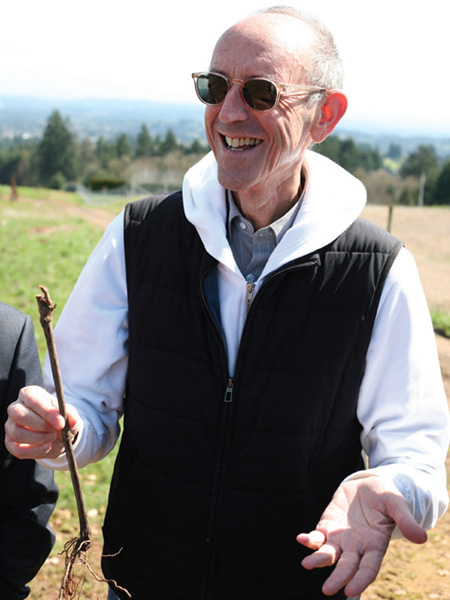

The wine from Black Walnut was the fattest and warmest of the four Tarlov brought to the office, and the map was festooned in the reds and yellows of deep, rich soils, with some lonely blue borders of rock. Another from blue zones of the Les Stevens Vineyard in Hopewell Hills shows its rockier provenance in tense reduction, what Tarlov said is a reaction to the vine stress at the site. It was a vineyard selection from the Chehalem Mountains that Liger-Belair considers first-growth quality, a selection that references light- and medium-blue sectors of fractured basalt at the site. It may be the most tightly structured, and showed itself more clearly going back to the wine a day later, the flavors dark and lasting, as was the tension in the tannins. The last bottle was from “the crazy rocky section of Dubay,” a vineyard in the Amity Hills, a selection Chapter 24 calls Stone Creek, based on sectors of turquoise, light blue and some dark blue on the maps. It would be challenging to describe this wine without resorting to comparisons to minerals, particularly iron, and meat, or meaty fruit, like a ripe cherry.
Perhaps the biggest chasm to bridge between Burgundy thought-leaders and Oregon pinot noir producers is in the concept of pinot noir itself. The Drouhins, Lafon, Liger-Belair, Lardière and Méo grow pinot noir to produce red Burgundy. The great names of Oregon grow pinot noir to produce and sell Oregon pinot noir.
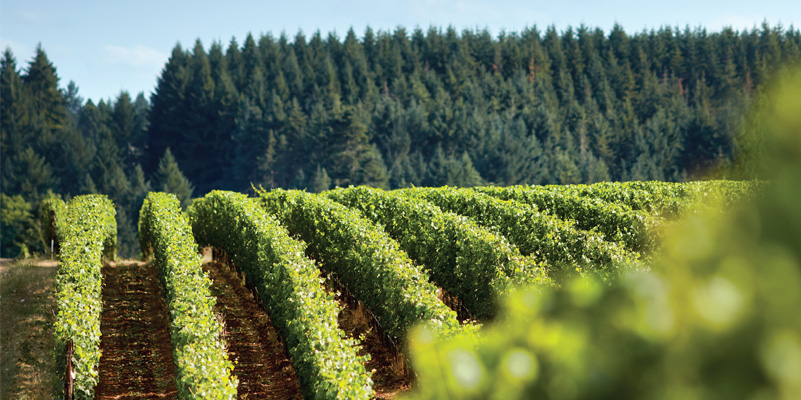

It would be a lot to ask for anyone in the New World to give up the words “pinot noir” on a label. After the variety began to gain traction among wine drinkers in the early 2000s, it catapulted into a starring role in Sideways; Hollywood promoted the lifestyle and the variety in a buddy movie and the market took off.
But when I bent Jacques Lardière’s ear at a large public tasting in Willamette, asking what he thought about the local reds, he whispered back that the wines were still in their infancy, breathing in, as the French like to do at the end of an exclamation.
There may be a basic level of disagreement about the nature of pinot noir. Most wine producers, and most wine drinkers, in the US expect pinot noir to be fruity and, in many cases, rich. And they have created a rich market for their wines, increasingly focused in the Willamette Valley.
In Burgundy, pinot noir is the plant growers use to produce their red wine, the vine they have trained to be as neutral as possible, to suppress anything that might be considered obvious varietal character and excessively fruity taste. There may be some fruit to add to the wine’s flesh (or it may taste more like meat, or like roots), but the bones are what shape it. They have trained the plant to signal what it is finding in the fractures of the rock. That’s what interests them and what interests the people who sustain the market for fine Burgundy.
In Oregon, no matter how quickly anyone accelerates the process of learning what’s underground, there’s still the plant, tuned to a different environment, not yet, perhaps, tuned to the soil that may make the most expressive red wine, the wine with the least noise and the clearest signal. That plant is yet to be born.
This archival feature has been brought in front of the paywall as part of our Regional Tasting Report on US Pinot Noir.
Joshua Greene is the editor and publisher of Wine & Spirits magazine.
This story appears in the print issue of April 2018.
Like what you read? Subscribe today.

